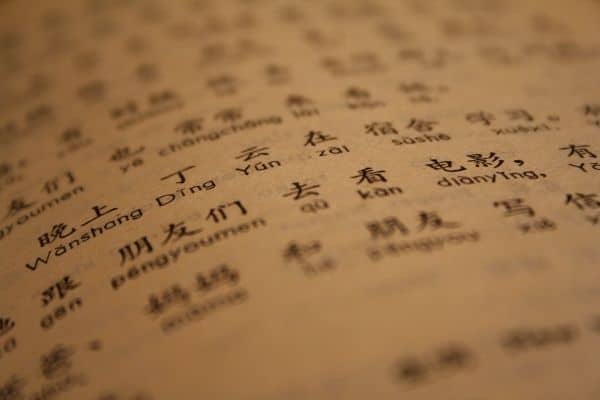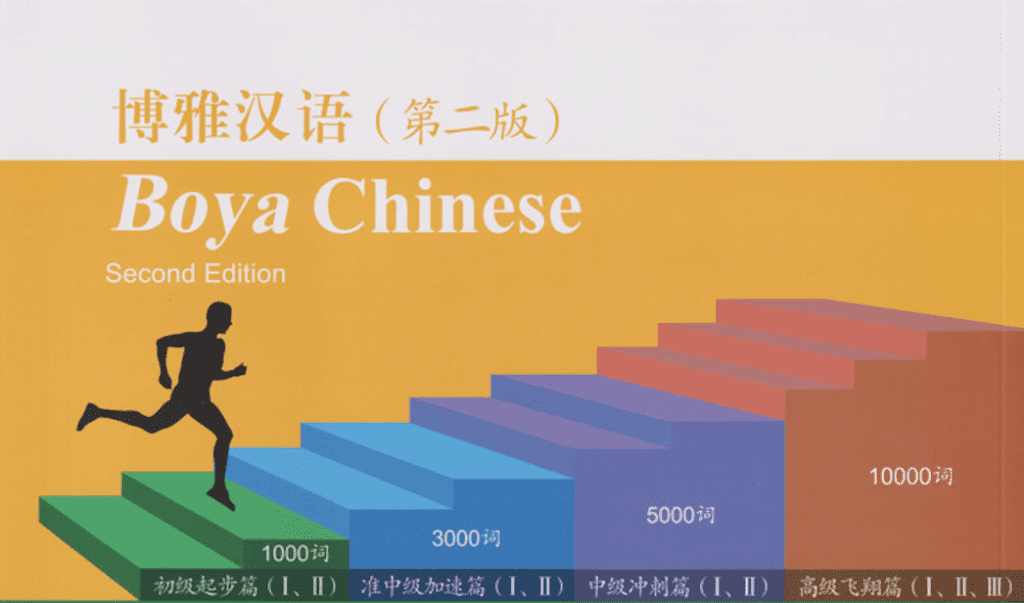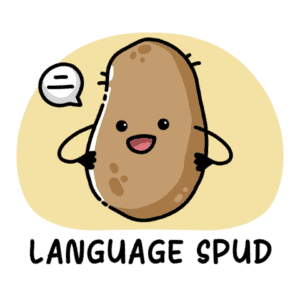
One of the biggest benefits to learners of Mandarin Chinese is the sheer number of learning resources available on the market. I’d even go as far as to say there are too many resources available. For Mandarin learning newbies, it can be difficult figuring out where to start.
These days, there are literally hundreds of apps, online courses, online tutor databases, and college programs for Mandarin learners.
But what about the good old-fashioned textbook? Does it still have a place in learning Mandarin?
Definitely YES.
Learning Mandarin with a textbook provides a ton of benefits that are often neglected in apps and other online courses. A good textbook provides a very strong foundation to your studies and will focus on all aspects of the language (vocabulary, grammar, reading, listening, speaking, writing). Not only that, but a good textbook can provide level appropriate study material for learners at every level.
Benefits of Learning with a Textbook
Let’s look at some reasons why textbooks are still a very important Mandarin learning tool and why you should consider using one.
Textbooks are cheap
You really don’t need to spend much to get your hands on a comprehensive textbook for beginners.
Some of the books on this list are roughly the same price as only a one-month subscription to popular online resources such as Chinesepod or Skritter.
Textbooks give structure to your learning
A common problem among beginner learners of Chinese is that they spread themselves too thinly by selecting too many resources to learn from, thus becoming overwhelmed.
A textbook is a good focal point for your learning.
It’s something you can build from as you gradually introduce other resources into your study routine.
Textbooks offer level appropriate material
A common complaint among beginners is the difficulty of finding learning content that’s level-appropriate.
Textbooks provide texts, audio, and activities that are suited to your level, all moving forward with a logical progression.
Beginner textbooks will teach you the foundations of characters
Understanding how Chinese characters are constructed is something that so many learners of Chinese gloss over without a second thought. I was one of those learners, and I ironically ended up taking longer to learn Chinese by trying to take this ‘shortcut’.
The main reason it’s helpful to learn the radicals and components of characters is this: if you’ve never seen the characters before but you know the radicals, you can often deduce meaning from the new characters.
There are good textbooks listed below will take the time to teach you this.
Textbooks will allow you to follow your own pace of learning
There are no monthly subscriptions or angry tutors standing over you to force your hand.
Once you’ve bought the textbook, it’s there on your shelf forever and you can pick it up whenever you want.
However, don’t let that cause you to take your foot off the gas!
Textbooks
The following textbooks are ones I have personally used and studied during my Mandarin learning journey, in addition to the most popular and highly reviewed on the market.
Boya Series
The Boya series is my favourite series of Mandarin textbooks. It was the core textbook used during my studies at Sun Yat-Sen University in Guangzhou back in 2017.
Like most textbooks, each chapter contains a word list and a dialogue introducing new vocabulary and one or two grammar structures.
The reason I favour the Boya series is because it does its best to keep the content functional for a foreigner new to China, while at the same time keeping the content closely in line with the HSK (Chinese proficiency test).
The Boya series is also rather comprehensive, with the advanced books covering language beyond the HSK 6 level.

Finishing the 2 elementary Boya books will put you between the HSK 3-4 mark.
Check out Boya Chinese: Elementary 1 here.
Developing Chinese
In addition to the Boya series, Developing Chinese textbooks are used on some language courses in Chinese universities.
The topics in the Developing Chinese series are really interesting.
The first two books (the second one found here) are all you need to take you from a complete beginner to lower intermediate. The handwriting booklet and audio CD are very effective, too.
Check out Developing Chinese: Elementary Course 1 here.
Integrated Chinese
This is probably the most common textbook used in Universities and colleges in the United States offering Mandarin programs to students of Chinese.
Although the content of the books is interesting, very well-reviewed, and comes with a host of excellent activities, there is one over-arching criticism of the book that I and many other users have.
For some reason, the content of the book forces the reader to be reliant on a Chinese tutor. If you don’t have one, the content of the book loses its effectiveness.
The earlier editions had an audio CD inside that isn’t there in the most recent editions, and you have to go to their website to download the audio to know how to pronounce the vocabulary in the book.
Integrated Chinese is awesome IF you have a Chinese tutor at hand. If you’re studying by yourself, I would recommend another book from this list.
Check out Integrated Chinese 4th Edition, Volume 1 here.
New Practical Chinese Reader
A very popular textbook for learners at every level, and contrary to the Integrated Chinese Series, this is an excellent book for those studying independently.
The New practical Chinese reader is especially useful for those who want to learn the more practical side of the language (not specifically to pass exams), as throughout the book it allows the reader to explore modern-day Chinese culture by following the lives of a few students in Beijing.
The books have been formatted with a mixture of culture, conversation, writing & reading. The text is focused on communication in everyday situations.
The only downside is that the audio CD isn’t included in the package and has to be bought separately (you can get it here).
Check out New Practical Chinese Reader Vol.1 Textbook here.
HSK Standard Set
Although some of the HSK textbooks aren’t always the most fascinating, if you learn directly in line with the HSK, you have a clear mark of progress and you are certain to be learning the most commonly used words in Mandarin as you move forward.
The content is structured well enough and the topics will be useful to you. The workbook audio will mirror the format of the audio on the HSK exam. I would suggest buying HSK 1 and 2 together because if you’re semi-serious about learning Chinese, you’ll fly through HSK 1 in no time.
If you’re unaware of the HSK, you can find a very useful guide below from LTL Mandarin School.
Also be aware that the HSK is going through some structural changes at the moment, so keep that in mind when preparing for the test or buying study materials.
Check out HSK Standard Course Set (Textbook+Workbook) here.
Writing Characters
Students of Mandarin often choose to double down on what is usually referred to as the most difficult area of learning Mandarin – writing characters.
Although I’d suggest taking your time with a more comprehensive textbook before buying another one geared solely to writing characters, here are a few suggestions for those who want to put extra effort into their writing.
Basic Mandarin Chinese – Reading & Writing by Cornelius C. Kubler
Not only does this guy have a great name, but he also creates great textbooks.
This book is a solid choice for beginners – a workbook for the 288 highest-frequency characters and 700 words in Chinese.
Designed to have you reading and writing simple, connected Chinese sentences quickly.
Reading and Writing Chinese: Third Edition, HSK All Levels
If you’re looking for a comprehensive writing textbook, this one should fit the bill.
This book could potentially lead you through a large part of your character writing journey as it covers all HSK levels from total beginner to advanced.
Learning Mandarin Chinese Characters Volume 1: The Quick and Easy Way to Learn Chinese Characters!
If you’re intimidated by the gigantic atlas of Chinese that is my previous suggestion, this one might be more up your street.
It will cover all of the bases of HSK 1 and give you plenty of space to practice.
Textbook Study Tips and Strategy
Flicking through your textbook once or twice isn’t going to get you very far when it comes to learning Mandarin Chinese.
Textbooks are a great resource to study Mandarin Chinese independently, but they have to be utilised in the right way to take effect.
Here are a few tips for you to get the most out of your textbook learning experience.
Don’t skip over parts of the book
Seriously, this is my biggest regret from my Mandarin studies as a beginner.
For example, I didn’t care at all about the radicals and components of Chinese characters when I started out.
I skipped over radicals, writing by hand, and all other essential basics, and as a result, I had to play catch up later down the line as I was still confusing characters all the time.
The authors of these books have gone to great trouble in creating their learning content, and there’ll be a number of reasons why the book is structured the way it is. You might be tempted to jump straight into HSK 6 and start learning astrophysics vocabulary, but please don’t.
Learning Mandarin Chinese is a marathon, not a sprint.
Do the supplemental exercises
They’re there for a reason.
They aren’t the key to unlocking fluency, but most textbook exercises are very helpful and will improve your understanding of the material significantly.
Complete the grammar exercises and don’t neglect supplemental material just because you find it difficult.
Repetition is key
When it comes to textbooks, I set a rule for myself a while ago that I still stick to today.
Spend one week learning one chapter.
Some may think that’s moving too slow, but I strongly suspect those people forget most of the content from a chapter of their textbooks within a few weeks.
Try the following and tell me how much your memory retention improves:
- Read the dialogue from your textbook a minimum of 50 times over the course of a week.
- Listen to the audio a minimum of 50 times over the course of a week.
- Slow the audio down and shadow it as many times as possible.
- Review the new vocabulary in your textbook with an SRS app or by sentence mining.
- Complete the supplemental material and write your own sentences using the taught grammar patterns.
Supplement your learning
Textbooks are great, but they can’t take you all the way to Mandarin fluency.
There isn’t a single resource that can do that.
As you move along your Mandarin learning journey, you’ll instinctively begin to know which skills need work and which study methods aren’t working.
If you want to investigate other Mandarin learning resources, check out my whopping list in Mandarin Learning Resources: Everything You’ll Ever Need for Fluency.
You can also check out some other helpful articles below.
